Ocala International Airport’s new terminal welcomes visitors with an artful look at where we’ve been and where we’re going.
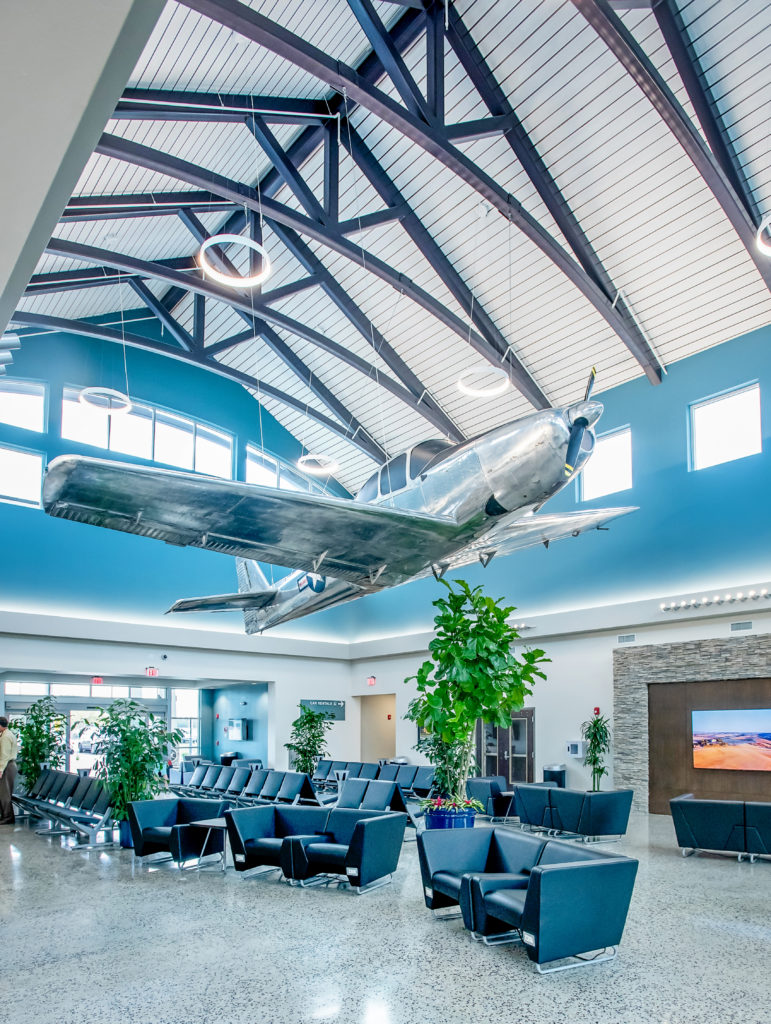 If you visit the new, $7.3 million terminal at Ocala International Airport often, you might bump into Eddie Martin, an unofficial tour guide through the history of aviation in Marion County.
If you visit the new, $7.3 million terminal at Ocala International Airport often, you might bump into Eddie Martin, an unofficial tour guide through the history of aviation in Marion County.
The 90-year-old conjures images of biplanes in the skies, of days when North Central Florida, including Ocala and Dunnellon, was a hive of World War II flight training.
Martin is a living link to the airport’s beginnings, having worked decades for the man largely responsible for building it, expanding it and later, moving it.
“I watched every bit of it go up,” Martin says of the new terminal. He could almost say the same about the airport over its entire history.
An Early Start
Martin recalls his mother telling him she spotted her son’s “affliction” when the Goodyear Blimp floated above their farm on the Suwannee River near Trenton: Baby Eddie took off after it wearing nothing but his diaper, which fell off.
“She said I wanted that balloon to land,” Martin recalls. “I wanted to touch it.”
Martin’s family moved to Marion County, near Dunnellon, where the World War II-era airfield now known as Ocala International Airport once bustled with military airmen in training. By his late teens he was a licensed pilot and mechanic. His practice of befriending influential people took him into the orbit of Rupert Caviness, a driving force in local aviation. Martin himself served as Ocala’s assistant airport manager for a few years in the 1950s.
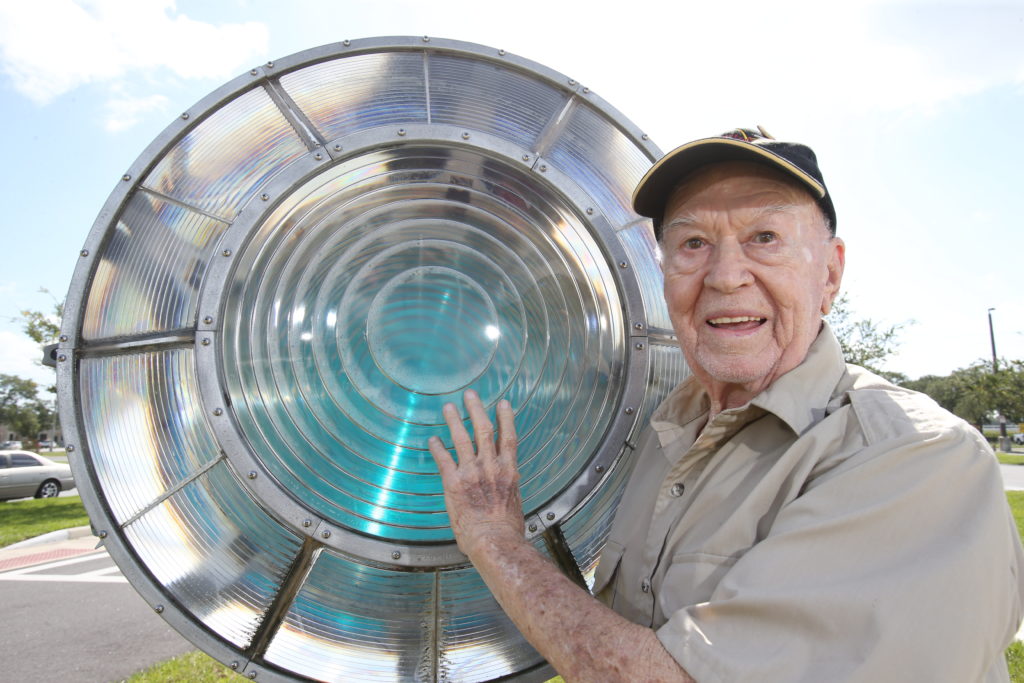 Martin’s remarkable career began when he was 14 and he got the newspaper concession for the Dunnellon airport, then being used for military training. Despite his age, he parlayed the paper route into a civilian job behind the bar at the officers’ club on the airbase.
Martin’s remarkable career began when he was 14 and he got the newspaper concession for the Dunnellon airport, then being used for military training. Despite his age, he parlayed the paper route into a civilian job behind the bar at the officers’ club on the airbase.
“They had five slot machines and a whole bunch of pinball machines,” Martin recalls, adding that one day, the provost marshal took a seat at the bar.
“He said, ‘Martin, how old are you?’ And I said, ‘You don’t really want to know, I don’t think,’” Martin remembers. “He said, ‘You are 21, aren’t you?’ I said, ‘No sir. Not by a pretty long shot.’”
Martin recalls that he delivered papers in the morning, attended school during the day and worked at the officers’ club at night. Meanwhile, he began to log flying hours through his friendships with instructors at the base, mainly in Aeronca L-3 aircraft. Martin says he learned the most about flying from Charles Adolf, an instructor at Greenville Aviation, the military flight training school based at Jim Taylor Field in Ocala. Adolf also taught Martin to paint airplanes, which led to a career in auto paint and bodywork for the Buick dealership of Rupert Caviness.
“Every morning I go by the airport,” Martin admits. “I know the girls behind the counter at Sheltair and I’ve established a friendship with them. They treat me very well, a lot better than they should an average, bumbling, 90-year-old man.”
Martin describes the new terminal as “fantastic.”
A Working Monument
The new terminal “nails” the first impression officials were looking to create in its design, according to Matt Grow, airport director.
The outside architecture evokes a horse-barn feeling and visitors are greeted by a row of lawn jockeys flanking the arrivals’ entrance, painted in the colors of local thoroughbred farms, which pays homage to the Horse Capital of the World’s signature industry.
Inside the spacious, modern terminal, contemporary seating arrangements mirror the blue-skies color palette and an 85-inch, high-definition, flat-screen television is girded by a stone façade that continues the luxe horse farm style. Overhead, a 1947 North American Navion plane is suspended from the ceiling, at what Grow explains is, “a slight pitch up and a right bank” that recalls the airport’s days as a military flight training facility during World War II.
This 17,500-square-foot facility is, as Grow reveals, a working monument to a county with a passion for flying that dates back more than a century.
On the grounds is a 12,000-square-foot Quonset hangar that was a landmark of the original “downtown” airport, inaugurated as Jim Taylor Field, which occupied a large wedge of land between State Road 200 and Southwest 17th Street.
On the walkway to the departures’ entrance is an antique beacon that took an interesting journey from Dunnellon to Ocala and guided pilots for decades.
The fascinating stories of the aviation hub’s history are alive and well, thanks to the leadership team’s enthusiasm for all things aeronautic.
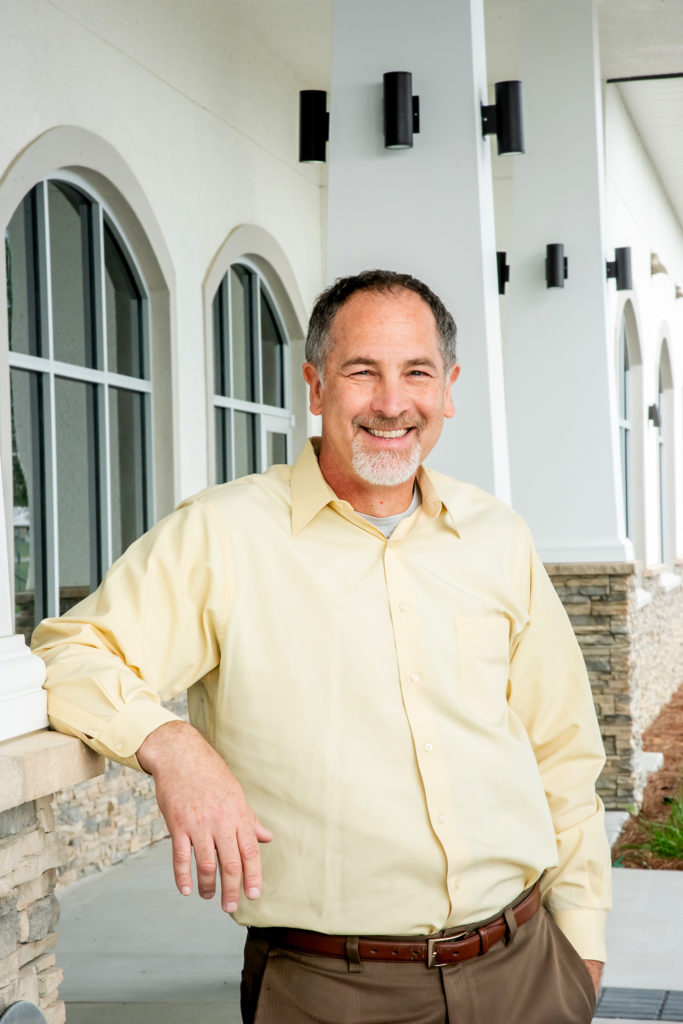 Grow, 49, who came to the airport from Steamboat Springs, Colorado, in 2005, describes himself as a “hopeless aviation romantic” who began flying hot-air balloons at 13 in a childhood that bounced between New Jersey and Pennsylvania. He says he earned licenses to fly balloons at 17 and planes at 18.
Grow, 49, who came to the airport from Steamboat Springs, Colorado, in 2005, describes himself as a “hopeless aviation romantic” who began flying hot-air balloons at 13 in a childhood that bounced between New Jersey and Pennsylvania. He says he earned licenses to fly balloons at 17 and planes at 18.
So how did the flying bug bite Grow at such an early age?
“Come with me,” he urges, walking in the direction of his new corner office.
On the way, Grow explains he inherited his love of flying from his father, Allan, who will turn 80 soon. Allan Grow never flew airplanes himself, but sketched, painted and built models of them, sparking his son’s imagination.
Arriving in the office, which has two picture-window views of planes parked on the apron, Matt Grow walks to a bookcase in the corner. The volumes include first-edition copies of aviation-related books from his father’s library, including Thirty Seconds Over Tokyo by Ted W. Lawson; Samurai! by Saburō Sakai; and The Great Santini by Pat Conroy.
Grow scans a row to the right with nonfiction works which feature his father’s art. He picks up War Wings, and opens it to a black-and-white illustration of a Messerschmitt Bf 109, a German World War II fighter.
“This one’s really amazing,” Matt Grow says, smiling proudly as he points out his father’s detail. “He basically dipped his pinky and camouflaged it. You can see his fingerprint in it.”
Drawing on his childhood, Grow says benches outside the terminal and his vision of a playground there someday are aimed at a particular kind of visitor.
“There’s the little kid that comes in who wants to see the airplanes take off and land,” he explains. “We can spur that interest and that growth in aviation.”
The Borrowed Beacon
David Cook, the longtime Ocala Star-Banner editor and Marion County historian, writes that Caviness, a pilot whose interest in aviation dated back to his military service during World War I, persuaded Jim Taylor, owner of the Ocala Manufacturing and Land Co., to donate land in the late 1920s for the original airport in Ocala that bore Taylor’s name. As a president of the Ocala City Council in the 1950s, Caviness led the effort to relocate the city airport, Cook writes. It began operating from its current home along Southwest 60th Avenue, now known as Airport Road, in 1968.
Martin remembers that in the early 1950s, after Adolf became manager of Jim Taylor Field during its years “downtown,” he served as his assistant manager. It was during this time, according to Martin, that the city airport’s old beacon went “kerflooey.” Martin knew the airport in Dunnellon had a working beacon—the artifact now on display outside the new Ocala International terminal.
Turning the beacon, Grow gets a twinkle in his eye as he relays the secondhand tale he heard of how Martin and some friends “liberated” the beacon from Dunnellon.
Martin himself recalls the move in terms less buccaneering: The airport in Dunnellon was getting practically no use, he explains, and it had a good beacon that Ocala needed, so Martin, his brother and a friend moved it with the help of a block and tackle.
“When you’re working for a municipality, you have all kind of people that know what you’re doing,” Martin offers. “You can’t shield much of anything, unless it’s illegal.”
Martin’s brief stint in airport management ended, he recalls, when Caviness begged him to return to his dealership. But Martin would still put his flying skills to use as a company pilot for Caviness and other Ocala car dealers.
“I flew them all over the eastern United States,” he recalls. “I remember going to Indianapolis, Indiana, numerous times. I had some pretty decent airplanes too. I was given the keys to about 12 different brand new ones. I was usually part owner or complete owner of most of them.”
While Martin savors his daily visits to Ocala International, he says he doesn’t expect air travel to return to what he calls “the golden years.”
“Too many distractions and regulations and dog-eat-dog business tactics just won’t let it happen,” he states.
History Lesson
Eddie Martin was one of the regulars hanging out at the Ocala airport when Terry Crawford returned to Ocala in 1970 after graduating from the University of Mississippi.
Crawford has served on the city’s Airport Advisory Board for 40 years. He says the new terminal “has been a work in progress for some time.”
“We have a new face on the entrance to Ocala,” Crawford remarks. “That’s really what we wanted
to accomplish.”
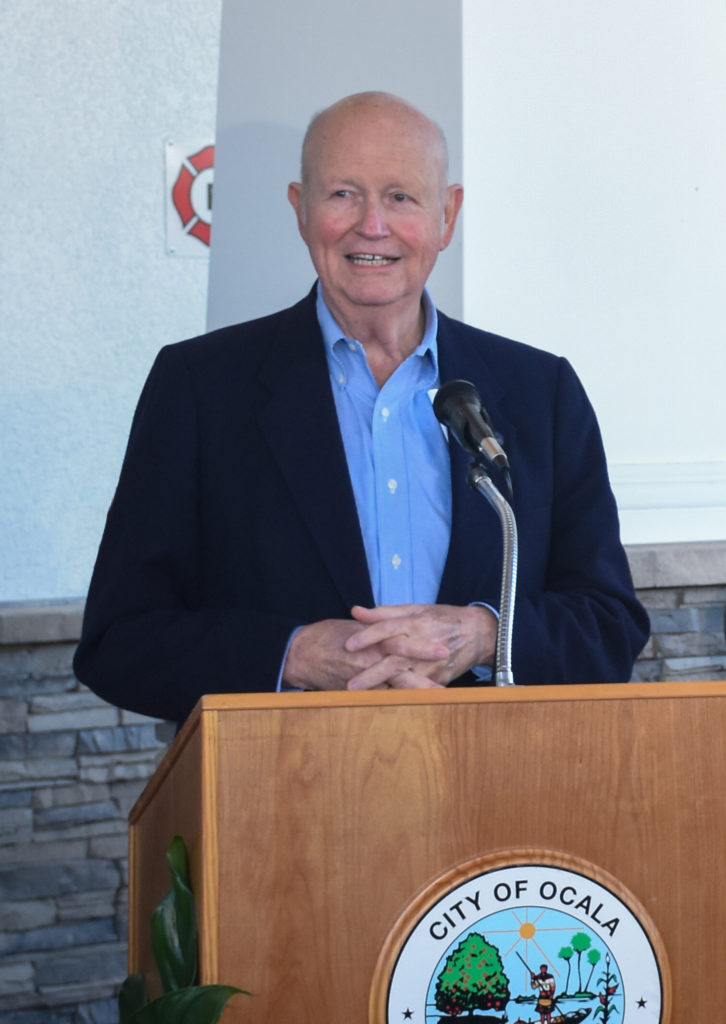 An Ocala native, Crawford can map the general dimensions of the old “downtown” Jim Taylor Field using current landmarks like Marion Technical College, Target, and State Road 200 car dealerships.
An Ocala native, Crawford can map the general dimensions of the old “downtown” Jim Taylor Field using current landmarks like Marion Technical College, Target, and State Road 200 car dealerships.
“Seventeenth Street originally ended at the railroad tracks, because that was the airport in front of you,” he recalls.
Crawford, however, learned his flying at Ole Miss and didn’t use the Ocala airport until it after it moved to Airport Road. Now 74, he comes from the family that started what is now Signature Brands. In the 1970s, Crawford himself launched Conimar Group, an Ocala manufacturer of housewares and tabletop products. His entrepreneurial success supports his aviation habit—he still flies—and Crawford has owned a number of planes over the years—including a Piper Cub he co-owned with Eddie Martin.
Crawford has a keen interest in Stearmans, the open-cockpit biplanes used as military trainers during World War II. In Ocala, civilian flight instructors trained Army Air Corps pilots on Stearmans at Jim Taylor Field in Ocala.
The end of the war saw a glut of Stearmans, which either “got cut up and melted and made into beer cans” or refashioned into crop dusting planes, according to Crawford.
In the late 1970s, Crawford recalls, he and Gid Thompson, a local crop duster pilot and plane restorer, began going to Stearman fly-ins. On an early trip, to Tennessee, Crawford bought a Stearman for a friend who didn’t have a pilot’s license and had Thompson fly it back to Ocala. He recalls watching with Eddie Martin as Thompson landed the plane.
“We tried to get him to take us for a ride in it and he said, ‘No. The last couple hundred miles, I swore that if I got the SOB on the ground, I was never going to get back in it,’” Crawford professes. “It needed a lot of work.”
At another Stearman meet, this one in West Helena, Arkansas, Crawford and Thompson bought three planes, mostly in pieces. Crawford recalls the restoration work stretching past a decade because he had another plane to fly. Around 1992, Crawford says, he showed one of the restored planes to a historian with the Stearman Restorers Association—and found out the craft had been built in 1941 and was assigned to Greenville Aviation in Ocala.
Commercial Considerations
As an airport board member, Crawford says he’s frequently asked if commercial air service will return to Ocala, where Eastern Air Lines had a terminal in Ocala from 1947-72. He has served on several task forces charged with bringing back commercial service but says “none got anywhere.” Crawford believes Ocala likely has a larger air service market than Gainesville, but Gainesville Regional Airport’s established commercial service has been in place since the 1950s.
“There’s too much parochialism,” he alleges. “They’ve already got the airport in Gainesville. Kids up there don’t want to give it up.”
Deborah James of Ocala is certain that demand exists for commercial service out of our airport. She worked from 1982-84 as a ticket agent in the Ocala airport for Air Florida, a commuter airline.
Then in her early 20s, James didn’t just sell tickets; she had to earn an “observation weather license” and also took passengers through a metal detector to their planes.
“I had no police officer there,” James recalls, laughing. “If anybody ever went through that metal detector and that thing went off, I don’t even know what I would have ever done. I was never trained for security.”
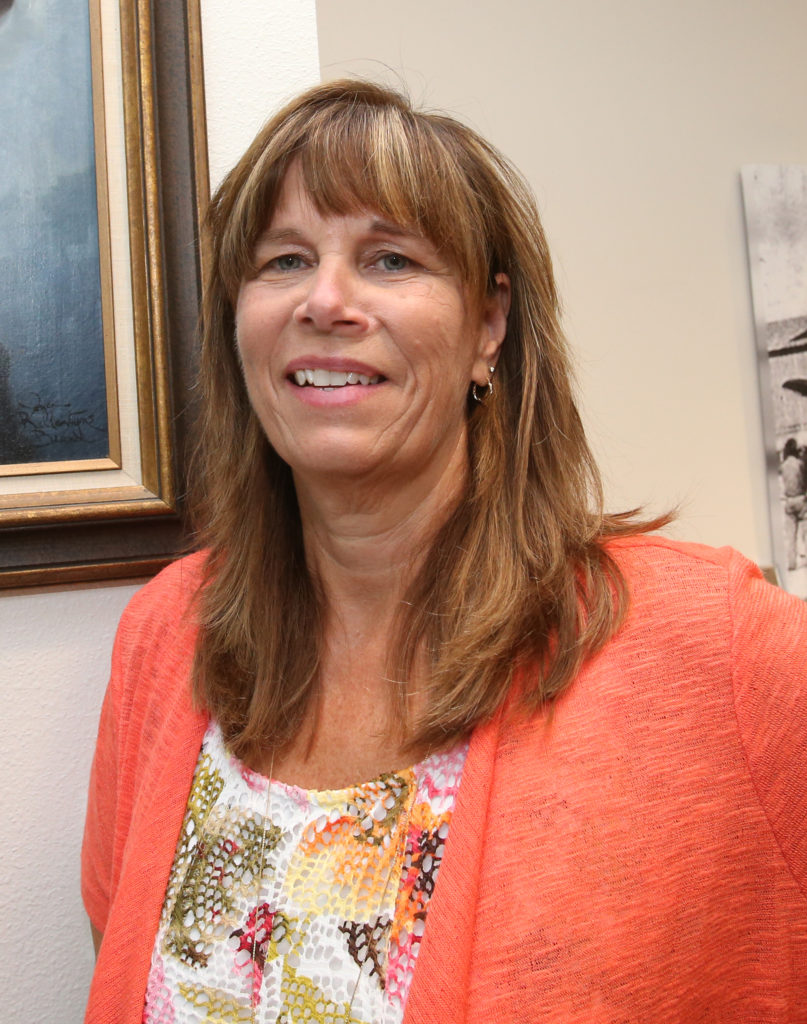
The risk at the time was low; James recalls handling about three flights per day of between 12 and 24 passengers per flight. Also in the terminal at the time was Allegheny Commuter, a one-man operation, she recalls.
That’s not to say James didn’t have the occasional interesting moment.
One time, a man and woman came to the metal detector with a baby. James remembers the couple had her hold the baby while they went through. After the plane departed, police arrived at the airport looking for the man and woman. James recalls officers telling her the couple were robbers trying to get to Miami and they likely handed her the baby to conceal a gun in the child’s blanket. Police later caught the duo, she explains.
Another time, a man walked out to the tarmac, took off his clothes and broke into a sprint, streaking down the runway.
What James calls her “best job ever” ended abruptly when Air Florida went belly up. She says after she began what would become a 20-year career with FedEx, she would still call the city in hopes they were bringing back commercial service. Now 60 and a real estate broker based in Belleview, she argues there’s no time like the present.
“My gosh, they’ve got that equine center coming in,” James offers. “People from all over the world are going to be there. So why not make our airport do what it’s supposed to do?”
Into the Future
Grow reveals that operations at Ocala International got “basically slashed in half” year over year in March and April due to COVID-19, but sees the World Equestrian Center and growth between Ocala and The Villages increasing demand. The airport has handled Air Force One and charter flights of Division I college teams coming to play the University of Florida Gators. Grow believes it could handle commercial traffic now.
“If the airlines thought they could make a dollar out of Ocala, they’d be here,” he asserts. I’m not anti-airline service. I think it’s going to come eventually, but it has to come when it’s right for the community. We can’t paint ourselves into a corner and be financially liable for a failed airline.”
In the meantime, Grow admits, he feeds off “the personality” of the airport as it is.
“I’m talking about the pilots and tenants and the different, diverse mix of people. You’ve got your recreational pilots. You’ve got the Terry Crawfords and the Eddie Martins that bring the history. You’ve got smaller business owners. There are physicians with offices throughout Florida that use their airplanes to fly between their offices so they can treat more people.
“It has a soul. There’s an essence to it. All of these people help make it and it’s really enjoyable to be a
part of that.”






